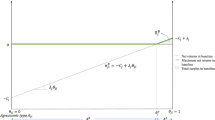Abstract
Global carbon trading may present a unique opportunity to change the rural landscape by allowing landowners to make an environmental impact with financial incentives. By enticing point source polluters to trade to an optimal level of pollution by offsetting their emissions with compatible carbon reduction projects, markets are able to facilitate a cleaner environment. Agroforestry provides a set of practices that can sequester carbon with managed tree and crop plantings. However, the initial lack of financial resources has been an obstacle to its adoption in the United States. This paper explores the potential for carbon offset trading to provide an added incentive to adopt agroforestry practices. Chicago Climate Exchange carbon sequestration projects are used as a baseline assessment, and the requirements that Missouri landowners would need to do in terms of contracting and ownership are identified. Data from landowners in central Missouri and the Ozarks (353 individuals) are used to determine characteristics of potentially interested landowners in agroforestry. A model to evaluate agroforestry profitability scenarios is used to compare the added carbon credit trading revenue to traditional alternate uses for the property. The findings from this analysis indicate that in the current context carbon trading does not provide an added incentive value for Missouri landowners to adopt either silvopasture or alley cropping practices because of the low magnitude of annual return.

Similar content being viewed by others
Notes
An earlier version of this article was presented for The 12th North American Agroforestry Conference - A Profitable Land Use, Athens, GA. on April 29, 2011. More detail on the interviews conducted for this article are reported in the proceedings paper.
References
AgEbb (2011) Farm budgets—AgEbb. University of Missouri, Columbia. http://agebb.missouri.edu/mgt/budget/. Accessed 20 April 2011
AgraGate (2011) AgraGate climate credits—carbon credits—forestry—eligibility. http://www.agragate.com/selling/fEligibility.aspx. Accessed 26 April 2011
Alavalapati JRR, Shrestha RK, Stainback GA, Matta JR (2004) Agroforestry development: an environmental economic perspective. Agrofor Syst 61–62:299–310
Barbieri C, Valdivia C (2010a) Recreation and agroforestry: examining new dimensions of multifunctionality in family farms. J Rural Stud 26:465–473
Barbieri C, Valdivia C (2010b) Recreational multifunctionality and its implications for agroforestry diffusion. Agrofor Syst 79:5–18
CCX (2009) Forestry carbon sequestration project protocol. Chicago Climate Exchange, Chicago
CCX (2011a) Overview. Chicago climate exchange. http://www.chicagoclimatex.com/content.jsf?id=821%5D. Accessed 26 April 2011
CCX (2011b) Transaction data. Chicago climate exchange. http://www.chicagoclimatex.com/content.jsf?id=1813%5D. Accessed 20 April 2011
Current D, Scheer K, Harting J, Xamora D, Ulland L (2007) A landowner’s guide to carbon sequestration credits. Central Minnesota Regional Sustainable Development Partnership
Diaz D, Hamilton K, Johnson E (2011) State of the forest carbon markets 2011: from canopy to currency. Ecosystem Marketplace, Washington, DC
Dosskey MG, Bentrup G, Schoeneberger M (2012) A role for agroforestry in forest restoration in the lower Mississippi alluvial valley. J Forest 110:48–55
Godsey LD (2005) Funding incentives for agroforestry in Missouri. University of Missouri Center for Agroforestry, Columbia
Godsey LD (2010a) Black walnut financial model (version 2.0). http://www.centerforagroforestry.org/profit/walnutfinancialmodel.php
Godsey LD (2010b) Economic budgeting for agroforestry practices. University of Missouri Center for Agroforestry, Columbia, p 12
Godsey LD (2010c) Modeling the financial impact of management decisions on loblolly pine (Pinus taeda) production. Ph.D. Dissertation, University of Missouri-Columbia
Linsenbigler M, Jones M, Hanson K, Preston B, Agapoff J, Moh K, Feather C, Barbarika A (2011) The Conservation Reserve Program. 41st signup September 2011. County by county summary. United States Department of Agriculture (ed), Washington, DC
Montagnini F, Nair PKR (2004) Carbon sequestration: an underexploited environmental benefit of agroforestry systems. Agrofor Syst 61:281–295
NDFU (2011) North Dakota farmers union carbon credit—tree planting. http://carboncredit.ndfu.org/forestry.html. Accessed 20 April 2011
Pattanayak SK, Mercer DE, Sills E, Sills E (2003) Taking stock of agroforestry adoption studies. Agrofor Syst 57:173–186
Schoeneberger M (2009) Agroforestry: working trees for sequestering carbon on agricultural lands. Agrofor Syst 75:27–37
USDA/NASS (2012) USDA/NASS QuickStats Ad-hoc query tool. http://quickstats.nass.usda.gov]. Accessed 7 February 2011 and 5 June 2012
Valdivia C (2006) HARC and Wurdack regions landowners survey. Columbia, MO
Valdivia C (2007) The effect of land fragmentation on habitus, field, and agroforestry in the midwest, USA. In: Olivier A, Campeau S (eds) When tree and crops get together: economic opportunities and environmental benefits from agroforestry. The Tenth North American Agroforestry Conference, Québec City, pp 621–633
Valdivia C, Poulos C (2009) Factors affecting farm operators’ interest in incorporating riparian buffers and forest farming practices in northeast and southeast Missouri. Agrofor Syst 75:61–71
Valdivia C, Gold M, Zabek L, Arbuckle J, Flora C (2009) Human and institutional dimensions of agroforestry. In: Garrett HE (ed) North American agroforestry: an integrated science and practice. America Society of Agronomy Inc., Madison, pp 339–367
Vatn A (2010) An institutional analysis of payments for environmental services. Ecol Econ 69:1245–1252
Acknowledgments
In order to develop an understanding of the process personal interviews were conducted with two of the most relevant aggregators for Missouri. David Miller is Director of Research and Commodity Services for the Iowa Farm Bureau Federation and runs the AgraGate program. M. Crist is a partner in Tatanka Resources, a Missouri based carbon management firm. Jason Holderieath would like to thank the participants of The 12th North American Agroforestry Conference—A Profitable Land Use, Athens, GA for their helpful comments and questions. Partial funding for this study was provided through the University of Missouri Center for Agroforestry under cooperative agreements 58-6227-1-004 with the ARS and C R 826704-01-2 with the US EPA. The results presented are the sole responsibility of the authors and do not necessarily reflect the view of the USDA.
Author information
Authors and Affiliations
Corresponding author
Rights and permissions
About this article
Cite this article
Holderieath, J., Valdivia, C., Godsey, L. et al. The potential for carbon offset trading to provide added incentive to adopt silvopasture and alley cropping in Missouri. Agroforest Syst 86, 345–353 (2012). https://doi.org/10.1007/s10457-012-9543-3
Received:
Accepted:
Published:
Issue Date:
DOI: https://doi.org/10.1007/s10457-012-9543-3




